International Business: Hofstede Model Analysis Report
VerifiedAdded on 2020/05/28
|6
|951
|996
Report
AI Summary
This report provides a critical analysis of Hofstede's cultural dimension model, a framework for understanding cross-cultural communication in international business. The report begins with an abstract and an introduction to Hofstede's model, explaining the five dimensions: power distance, uncertainty avoidance, individualism versus collectivism, masculinity versus femininity, and long-term versus short-term orientation. It then presents arguments in favor of the model, highlighting its relevance and attention to detail in comparing cultural differences. The report also discusses arguments against the model, such as cultural homogeneity, political influences, the limitations of the dimensions, and the model's potential to be outdated. The report concludes by referencing several academic sources that support the analysis of the model and its implications for international business.
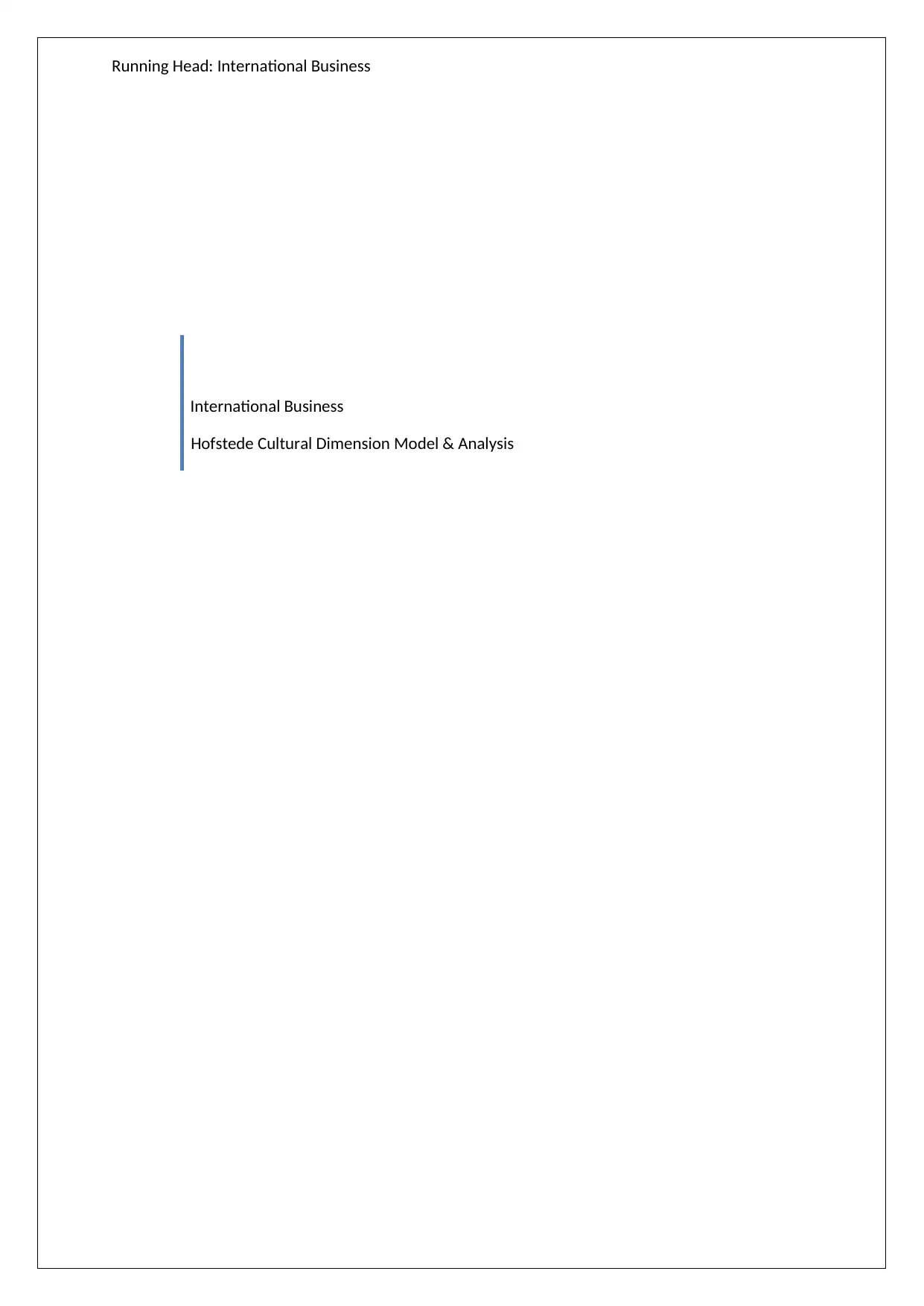
Running Head: International Business
International Business
Hofstede Cultural Dimension Model & Analysis
International Business
Hofstede Cultural Dimension Model & Analysis
Paraphrase This Document
Need a fresh take? Get an instant paraphrase of this document with our AI Paraphraser
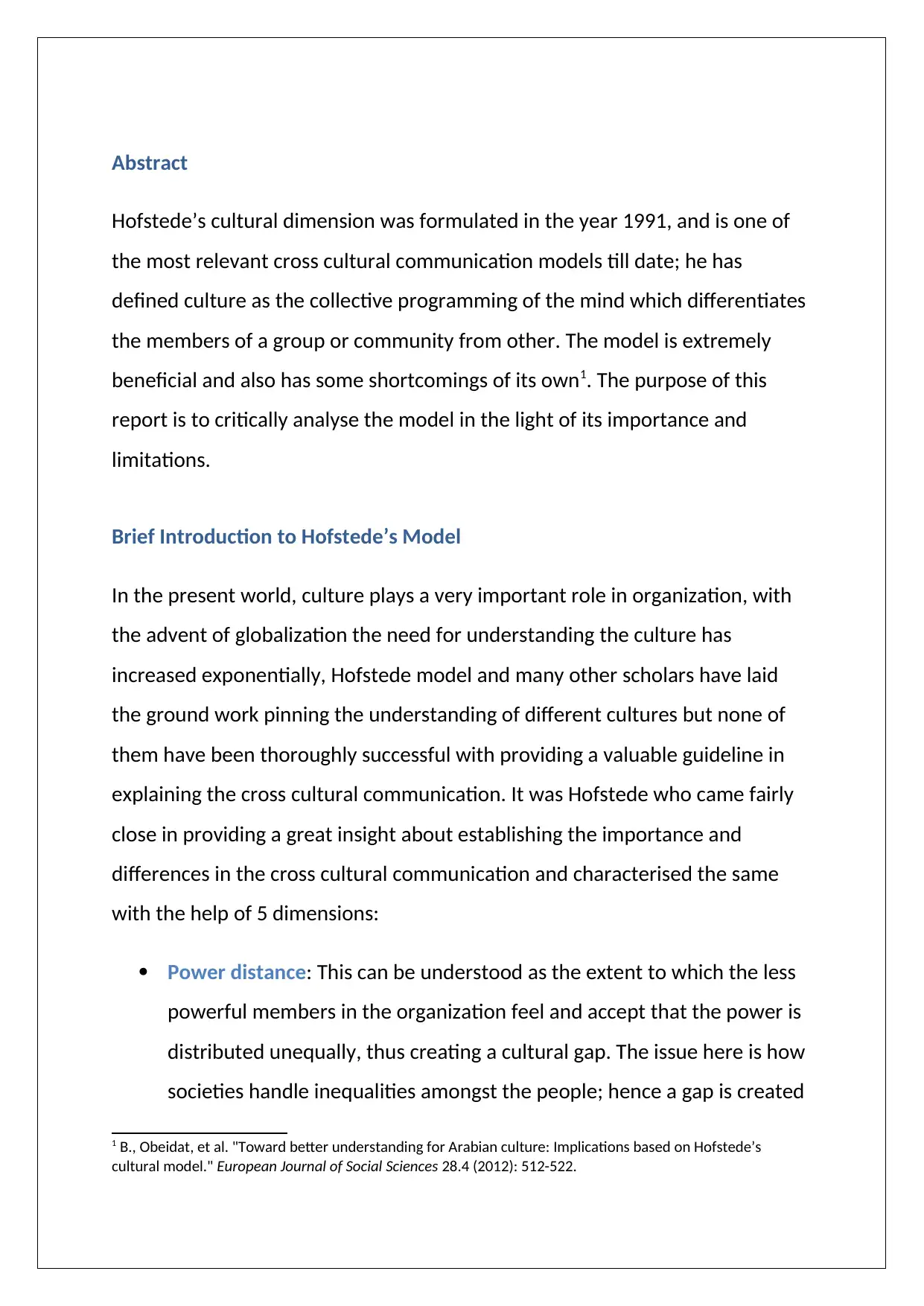
Abstract
Hofstede’s cultural dimension was formulated in the year 1991, and is one of
the most relevant cross cultural communication models till date; he has
defined culture as the collective programming of the mind which differentiates
the members of a group or community from other. The model is extremely
beneficial and also has some shortcomings of its own1. The purpose of this
report is to critically analyse the model in the light of its importance and
limitations.
Brief Introduction to Hofstede’s Model
In the present world, culture plays a very important role in organization, with
the advent of globalization the need for understanding the culture has
increased exponentially, Hofstede model and many other scholars have laid
the ground work pinning the understanding of different cultures but none of
them have been thoroughly successful with providing a valuable guideline in
explaining the cross cultural communication. It was Hofstede who came fairly
close in providing a great insight about establishing the importance and
differences in the cross cultural communication and characterised the same
with the help of 5 dimensions:
Power distance: This can be understood as the extent to which the less
powerful members in the organization feel and accept that the power is
distributed unequally, thus creating a cultural gap. The issue here is how
societies handle inequalities amongst the people; hence a gap is created
1 B., Obeidat, et al. "Toward better understanding for Arabian culture: Implications based on Hofstede’s
cultural model." European Journal of Social Sciences 28.4 (2012): 512-522.
Hofstede’s cultural dimension was formulated in the year 1991, and is one of
the most relevant cross cultural communication models till date; he has
defined culture as the collective programming of the mind which differentiates
the members of a group or community from other. The model is extremely
beneficial and also has some shortcomings of its own1. The purpose of this
report is to critically analyse the model in the light of its importance and
limitations.
Brief Introduction to Hofstede’s Model
In the present world, culture plays a very important role in organization, with
the advent of globalization the need for understanding the culture has
increased exponentially, Hofstede model and many other scholars have laid
the ground work pinning the understanding of different cultures but none of
them have been thoroughly successful with providing a valuable guideline in
explaining the cross cultural communication. It was Hofstede who came fairly
close in providing a great insight about establishing the importance and
differences in the cross cultural communication and characterised the same
with the help of 5 dimensions:
Power distance: This can be understood as the extent to which the less
powerful members in the organization feel and accept that the power is
distributed unequally, thus creating a cultural gap. The issue here is how
societies handle inequalities amongst the people; hence a gap is created
1 B., Obeidat, et al. "Toward better understanding for Arabian culture: Implications based on Hofstede’s
cultural model." European Journal of Social Sciences 28.4 (2012): 512-522.
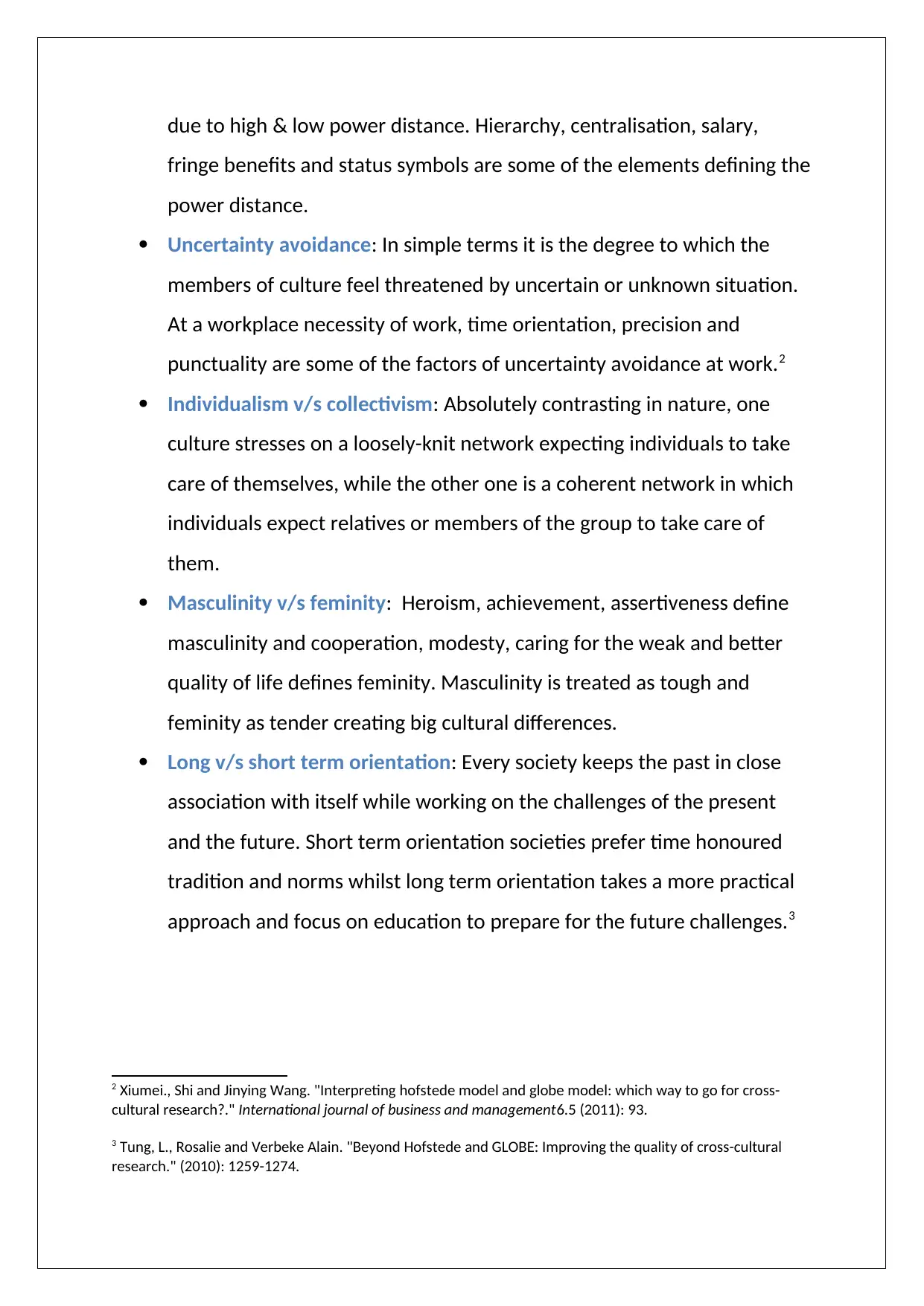
due to high & low power distance. Hierarchy, centralisation, salary,
fringe benefits and status symbols are some of the elements defining the
power distance.
Uncertainty avoidance: In simple terms it is the degree to which the
members of culture feel threatened by uncertain or unknown situation.
At a workplace necessity of work, time orientation, precision and
punctuality are some of the factors of uncertainty avoidance at work.2
Individualism v/s collectivism: Absolutely contrasting in nature, one
culture stresses on a loosely-knit network expecting individuals to take
care of themselves, while the other one is a coherent network in which
individuals expect relatives or members of the group to take care of
them.
Masculinity v/s feminity: Heroism, achievement, assertiveness define
masculinity and cooperation, modesty, caring for the weak and better
quality of life defines feminity. Masculinity is treated as tough and
feminity as tender creating big cultural differences.
Long v/s short term orientation: Every society keeps the past in close
association with itself while working on the challenges of the present
and the future. Short term orientation societies prefer time honoured
tradition and norms whilst long term orientation takes a more practical
approach and focus on education to prepare for the future challenges.3
2 Xiumei., Shi and Jinying Wang. "Interpreting hofstede model and globe model: which way to go for cross-
cultural research?." International journal of business and management6.5 (2011): 93.
3 Tung, L., Rosalie and Verbeke Alain. "Beyond Hofstede and GLOBE: Improving the quality of cross-cultural
research." (2010): 1259-1274.
fringe benefits and status symbols are some of the elements defining the
power distance.
Uncertainty avoidance: In simple terms it is the degree to which the
members of culture feel threatened by uncertain or unknown situation.
At a workplace necessity of work, time orientation, precision and
punctuality are some of the factors of uncertainty avoidance at work.2
Individualism v/s collectivism: Absolutely contrasting in nature, one
culture stresses on a loosely-knit network expecting individuals to take
care of themselves, while the other one is a coherent network in which
individuals expect relatives or members of the group to take care of
them.
Masculinity v/s feminity: Heroism, achievement, assertiveness define
masculinity and cooperation, modesty, caring for the weak and better
quality of life defines feminity. Masculinity is treated as tough and
feminity as tender creating big cultural differences.
Long v/s short term orientation: Every society keeps the past in close
association with itself while working on the challenges of the present
and the future. Short term orientation societies prefer time honoured
tradition and norms whilst long term orientation takes a more practical
approach and focus on education to prepare for the future challenges.3
2 Xiumei., Shi and Jinying Wang. "Interpreting hofstede model and globe model: which way to go for cross-
cultural research?." International journal of business and management6.5 (2011): 93.
3 Tung, L., Rosalie and Verbeke Alain. "Beyond Hofstede and GLOBE: Improving the quality of cross-cultural
research." (2010): 1259-1274.
⊘ This is a preview!⊘
Do you want full access?
Subscribe today to unlock all pages.

Trusted by 1+ million students worldwide
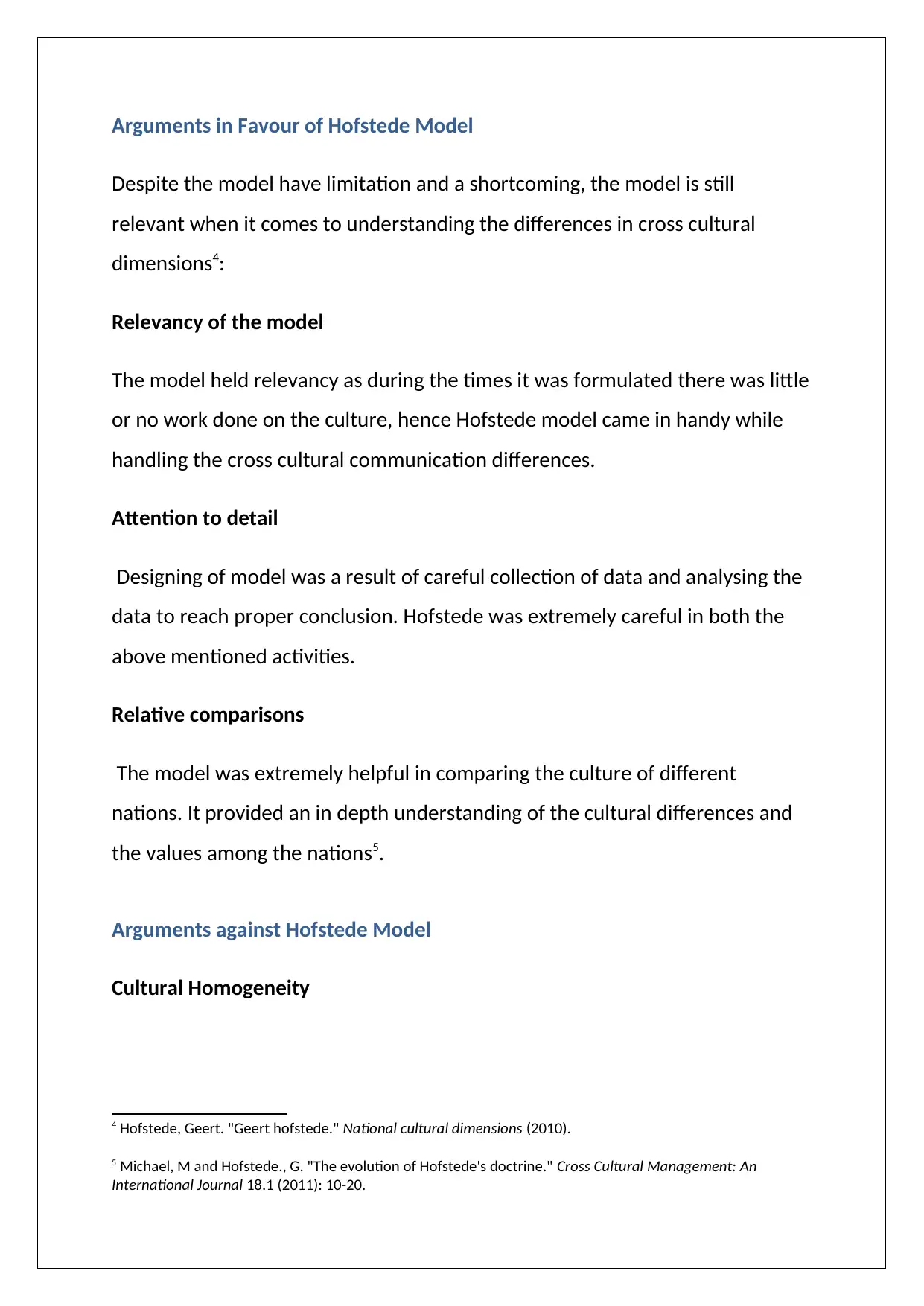
Arguments in Favour of Hofstede Model
Despite the model have limitation and a shortcoming, the model is still
relevant when it comes to understanding the differences in cross cultural
dimensions4:
Relevancy of the model
The model held relevancy as during the times it was formulated there was little
or no work done on the culture, hence Hofstede model came in handy while
handling the cross cultural communication differences.
Attention to detail
Designing of model was a result of careful collection of data and analysing the
data to reach proper conclusion. Hofstede was extremely careful in both the
above mentioned activities.
Relative comparisons
The model was extremely helpful in comparing the culture of different
nations. It provided an in depth understanding of the cultural differences and
the values among the nations5.
Arguments against Hofstede Model
Cultural Homogeneity
4 Hofstede, Geert. "Geert hofstede." National cultural dimensions (2010).
5 Michael, M and Hofstede., G. "The evolution of Hofstede's doctrine." Cross Cultural Management: An
International Journal 18.1 (2011): 10-20.
Despite the model have limitation and a shortcoming, the model is still
relevant when it comes to understanding the differences in cross cultural
dimensions4:
Relevancy of the model
The model held relevancy as during the times it was formulated there was little
or no work done on the culture, hence Hofstede model came in handy while
handling the cross cultural communication differences.
Attention to detail
Designing of model was a result of careful collection of data and analysing the
data to reach proper conclusion. Hofstede was extremely careful in both the
above mentioned activities.
Relative comparisons
The model was extremely helpful in comparing the culture of different
nations. It provided an in depth understanding of the cultural differences and
the values among the nations5.
Arguments against Hofstede Model
Cultural Homogeneity
4 Hofstede, Geert. "Geert hofstede." National cultural dimensions (2010).
5 Michael, M and Hofstede., G. "The evolution of Hofstede's doctrine." Cross Cultural Management: An
International Journal 18.1 (2011): 10-20.
Paraphrase This Document
Need a fresh take? Get an instant paraphrase of this document with our AI Paraphraser
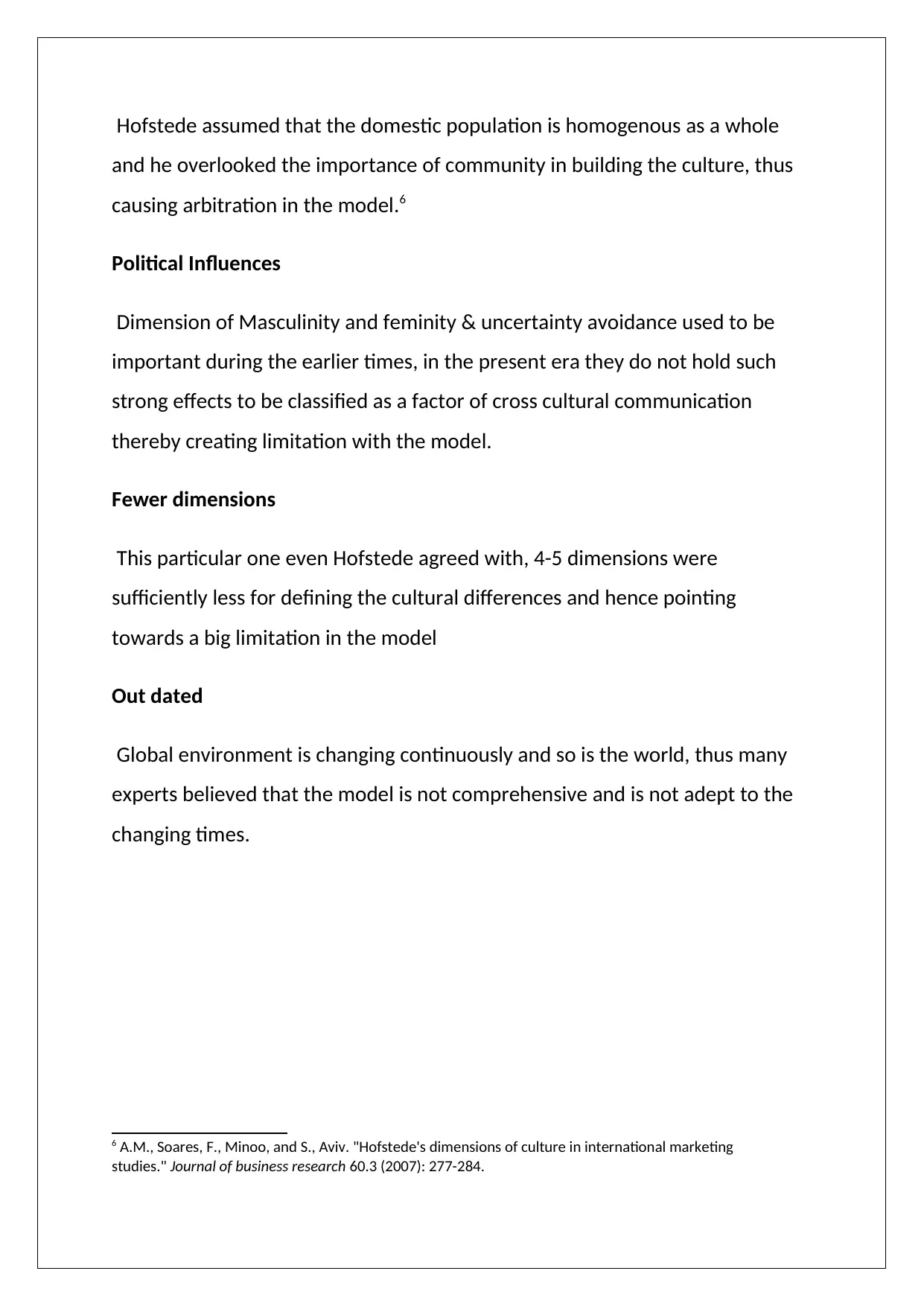
Hofstede assumed that the domestic population is homogenous as a whole
and he overlooked the importance of community in building the culture, thus
causing arbitration in the model.6
Political Influences
Dimension of Masculinity and feminity & uncertainty avoidance used to be
important during the earlier times, in the present era they do not hold such
strong effects to be classified as a factor of cross cultural communication
thereby creating limitation with the model.
Fewer dimensions
This particular one even Hofstede agreed with, 4-5 dimensions were
sufficiently less for defining the cultural differences and hence pointing
towards a big limitation in the model
Out dated
Global environment is changing continuously and so is the world, thus many
experts believed that the model is not comprehensive and is not adept to the
changing times.
6 A.M., Soares, F., Minoo, and S., Aviv. "Hofstede's dimensions of culture in international marketing
studies." Journal of business research 60.3 (2007): 277-284.
and he overlooked the importance of community in building the culture, thus
causing arbitration in the model.6
Political Influences
Dimension of Masculinity and feminity & uncertainty avoidance used to be
important during the earlier times, in the present era they do not hold such
strong effects to be classified as a factor of cross cultural communication
thereby creating limitation with the model.
Fewer dimensions
This particular one even Hofstede agreed with, 4-5 dimensions were
sufficiently less for defining the cultural differences and hence pointing
towards a big limitation in the model
Out dated
Global environment is changing continuously and so is the world, thus many
experts believed that the model is not comprehensive and is not adept to the
changing times.
6 A.M., Soares, F., Minoo, and S., Aviv. "Hofstede's dimensions of culture in international marketing
studies." Journal of business research 60.3 (2007): 277-284.
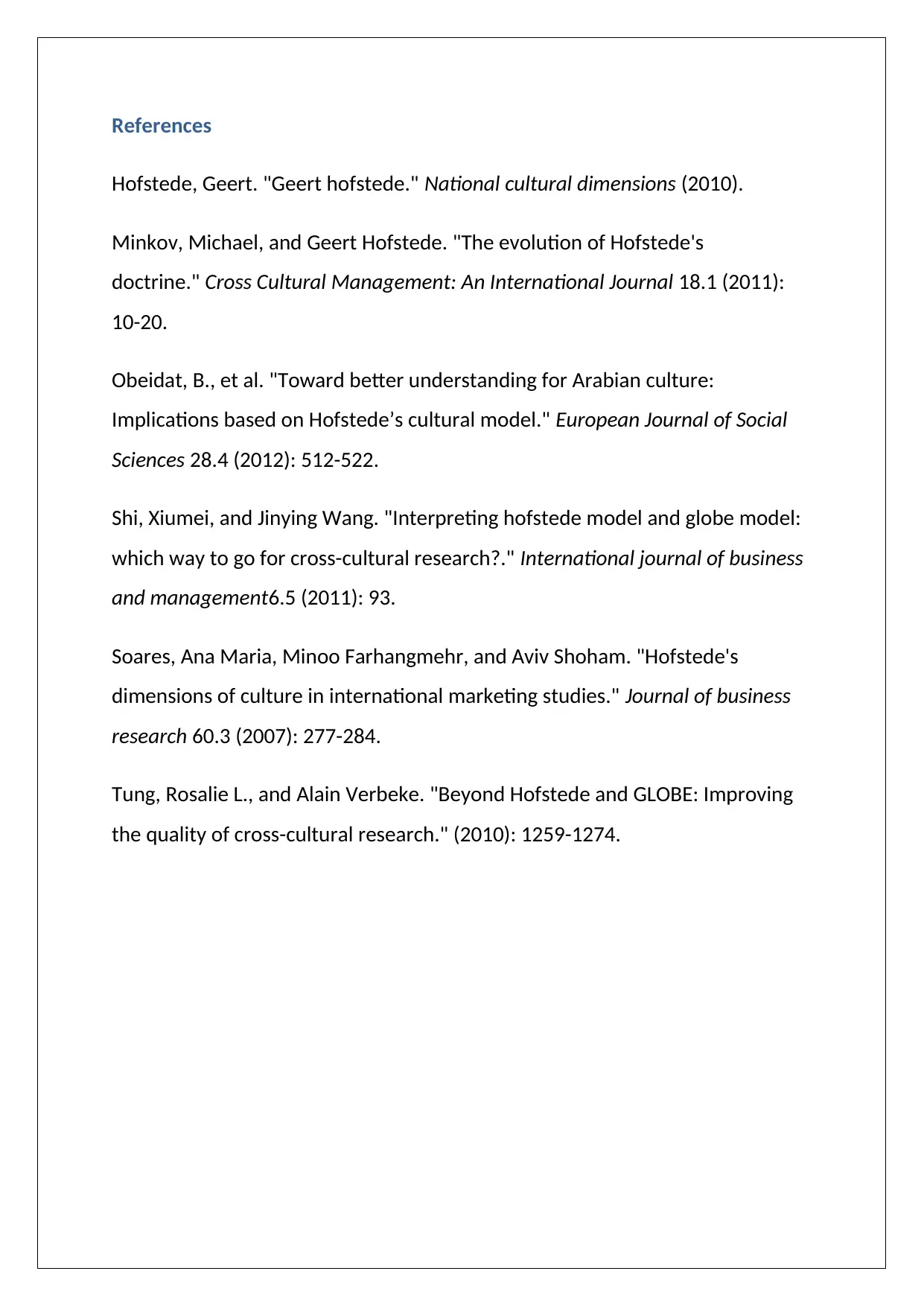
References
Hofstede, Geert. "Geert hofstede." National cultural dimensions (2010).
Minkov, Michael, and Geert Hofstede. "The evolution of Hofstede's
doctrine." Cross Cultural Management: An International Journal 18.1 (2011):
10-20.
Obeidat, B., et al. "Toward better understanding for Arabian culture:
Implications based on Hofstede’s cultural model." European Journal of Social
Sciences 28.4 (2012): 512-522.
Shi, Xiumei, and Jinying Wang. "Interpreting hofstede model and globe model:
which way to go for cross-cultural research?." International journal of business
and management6.5 (2011): 93.
Soares, Ana Maria, Minoo Farhangmehr, and Aviv Shoham. "Hofstede's
dimensions of culture in international marketing studies." Journal of business
research 60.3 (2007): 277-284.
Tung, Rosalie L., and Alain Verbeke. "Beyond Hofstede and GLOBE: Improving
the quality of cross-cultural research." (2010): 1259-1274.
Hofstede, Geert. "Geert hofstede." National cultural dimensions (2010).
Minkov, Michael, and Geert Hofstede. "The evolution of Hofstede's
doctrine." Cross Cultural Management: An International Journal 18.1 (2011):
10-20.
Obeidat, B., et al. "Toward better understanding for Arabian culture:
Implications based on Hofstede’s cultural model." European Journal of Social
Sciences 28.4 (2012): 512-522.
Shi, Xiumei, and Jinying Wang. "Interpreting hofstede model and globe model:
which way to go for cross-cultural research?." International journal of business
and management6.5 (2011): 93.
Soares, Ana Maria, Minoo Farhangmehr, and Aviv Shoham. "Hofstede's
dimensions of culture in international marketing studies." Journal of business
research 60.3 (2007): 277-284.
Tung, Rosalie L., and Alain Verbeke. "Beyond Hofstede and GLOBE: Improving
the quality of cross-cultural research." (2010): 1259-1274.
⊘ This is a preview!⊘
Do you want full access?
Subscribe today to unlock all pages.

Trusted by 1+ million students worldwide
1 out of 6
Related Documents
Your All-in-One AI-Powered Toolkit for Academic Success.
+13062052269
info@desklib.com
Available 24*7 on WhatsApp / Email
![[object Object]](/_next/static/media/star-bottom.7253800d.svg)
Unlock your academic potential
Copyright © 2020–2025 A2Z Services. All Rights Reserved. Developed and managed by ZUCOL.





